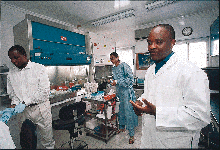
PROFILE:
Building a World-Class Lab From Scratch
Jon Cohen*
Photos by Malcolm Linton
ABIDJAN, CÔTE D'IVOIRE--Shortly after Cameroon first started broadcasting television programs in 1984, John Nkengasong, then a student at the University of Yaoundé, remembers watching a show that featured veterinary scientists working in a laboratory. "I didn't even know what research was," recalls Nkengasong, the son of a Cameroonian subsistence farmer. Now Nkengasong, a virologist at Projet RETRO-CI here, runs one of the best equipped HIV labs in sub-Saharan Africa and has published dozens of papers helping to clarify properties of specific strains of the virus.
Projet RETRO-CI, a U.S.-Ivoirian collaboration funded by the U.S. Centers for Disease Control and Prevention (CDC), hired Nkengasong in 1996 to build a virology lab from scratch. As Nkengasong leads a tour of his lab, it's clear that scientists working in wealthy countries might well envy him. Dangerous viruses like HIV must be handled in sealed and aerated biosafety rooms. Nkengasong has two such P-3 rooms, one for HIV-1 and, to avoid contamination problems, another for the less common HIV-2. He has late-model polymerase chain reaction machines to amplify small amounts of DNA, a procedure routinely done in developed countries to determine how much virus people have in their blood--their "viral load." A new DNA sequencing machine sits on one table and a sleek new Apple iMac computer on another. "There's nothing we can't do here," says Nkengasong.

Trained brain Cameroonian virologist John Nkengasong says "there's nothing we can't do" at his well-equipped Project RETRO-Cl lab in Abidjan.
After graduating from Yaoundé in 1987, Nkengasong won a scholarship to study in Belgium with Peter Piot at the Institute of Tropical Medicine in Antwerp. "He's the first African I put in charge of a lab in Belgium," remembers Piot, who now heads UNAIDS and has trained several African AIDS researchers. "I really had a lot of confidence in him and am proud of his accomplishments."
Nkengasong says he badly wanted to return to Africa after completing his Ph.D. in virology at the University of Brussels. "There are many people in the States who are better than I am," he says. "I can contribute to the development of Africa here." But he could not find an attractive job in Cameroon. "The structures in Africa are not always there to receive the brains that are trained," he says. When the chance to head the virology lab at RETRO-CI came up, Nkengasong jumped at it.
A key part of Nkengasong's current work involves measuring viral loads, which can provide information essential for treatment and for critical research topics such as how much HIV a woman has in her breast milk or in cervicovaginal secretions. Nkengasong and his co-workers also have analyzed the subtypes of HIV-1 and HIV-2 circulating in Abidjan, which may lead to better screening tests for these viruses and, separately, help vaccine developers (see p. 2165).
Nkengasong worries about the project's reliance on "soft money" from the CDC. "I'm always wondering about the day CDC won't do this," he says. "Can the Ivoirians sustain this?" Ultimately, he believes, the lab could survive on grant money. "In 2 or 3 more years," he predicts, "I'll be as competitive as any lab in the world."
* Jon Cohen was accompanied by photographer Malcolm Linton. For a gallery of additional photos and the stories behind them, see
www.sciencemag.org/feature/data/aids_africa/gallery.shl.
Volume 288,
Number 5474,
Issue of 23 Jun 2000,
p. 2157.
Copyright © 2000 by The American Association for the Advancement of Science.
|